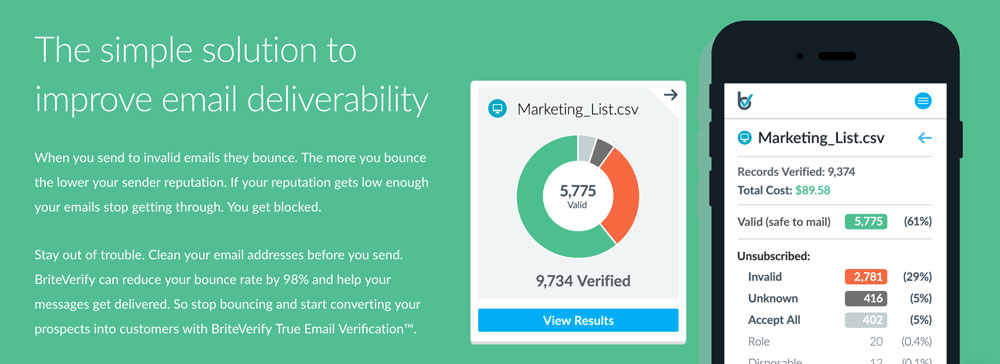BriteVerify
Friday, January 20th, 2017 | Tech

Email is a word of trouble these days. Most of it spam. So everyone, ISPs and users alike, put up huge defences against the spam. These are typically so aggressive that a huge amount of legitimate email gets caught in the net. For example, gMail categorises anyone emailing Anxiety Leeds as spam. Most ISPs block any email from Leeds Skeptics also.
However, email is still really useful and probably the most powerful form of online communication, so everyone is still using it. You have to find a way to make it work. One of the important ways of doing this is protecting your reputation. You cannot be sending emails to the wrong accounts, or accounts that do not exist.
When I started a course to teach IT contracting, I had a problem. I was giving away my first set of lessons, and a book. All you have to do is register and you get it all for free. But people were registering with fake email addresses or other people’s email addresses. To stop this, I put in a double-opt-in system, in which you had to click the link I emailed to you.
However, still meant I had to send an email to a possibly fake email address. Not to mention that people started using disposable email addresses.
So, I integrated BriteVerify. They have an API where you can check whether an email address exists or not. They check the MX records of a domain, filter out disposable email addresses, and does a few other checks.
Does it work? Mostly, yes. It passed on all the test email addresses I gave it. In the real world, it is not perfect, but it does provide an easy way for me to automatically screen out obvious fakes. They maintain a list of disposable email address providers for example. I have my own blacklist, but there’s is much more comprehensive than mine.
The downside is that a) it costs money ($0.01 per check with no free tier) and b) that it will slightly slow down the response times of my page while I am speaking to their API. Given that registration is a one-time process, though, so far it has proven worth it.

Email is a word of trouble these days. Most of it spam. So everyone, ISPs and users alike, put up huge defences against the spam. These are typically so aggressive that a huge amount of legitimate email gets caught in the net. For example, gMail categorises anyone emailing Anxiety Leeds as spam. Most ISPs block any email from Leeds Skeptics also.
However, email is still really useful and probably the most powerful form of online communication, so everyone is still using it. You have to find a way to make it work. One of the important ways of doing this is protecting your reputation. You cannot be sending emails to the wrong accounts, or accounts that do not exist.
When I started a course to teach IT contracting, I had a problem. I was giving away my first set of lessons, and a book. All you have to do is register and you get it all for free. But people were registering with fake email addresses or other people’s email addresses. To stop this, I put in a double-opt-in system, in which you had to click the link I emailed to you.
However, still meant I had to send an email to a possibly fake email address. Not to mention that people started using disposable email addresses.
So, I integrated BriteVerify. They have an API where you can check whether an email address exists or not. They check the MX records of a domain, filter out disposable email addresses, and does a few other checks.
Does it work? Mostly, yes. It passed on all the test email addresses I gave it. In the real world, it is not perfect, but it does provide an easy way for me to automatically screen out obvious fakes. They maintain a list of disposable email address providers for example. I have my own blacklist, but there’s is much more comprehensive than mine.
The downside is that a) it costs money ($0.01 per check with no free tier) and b) that it will slightly slow down the response times of my page while I am speaking to their API. Given that registration is a one-time process, though, so far it has proven worth it.